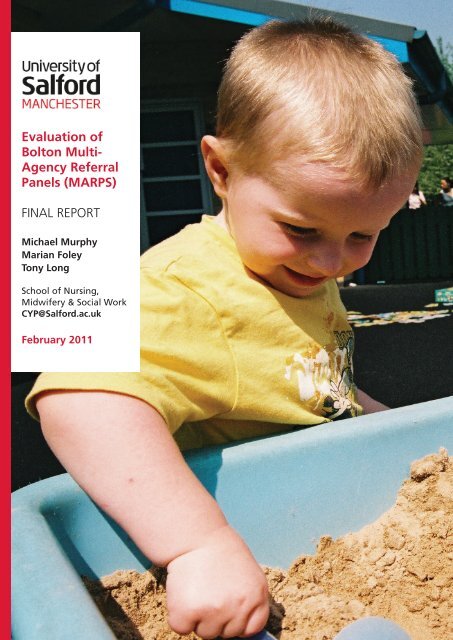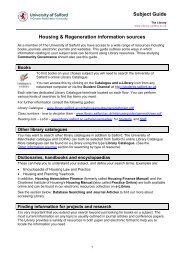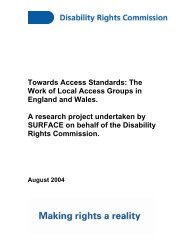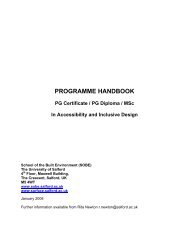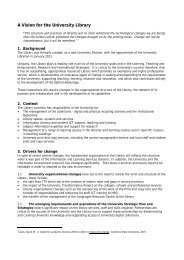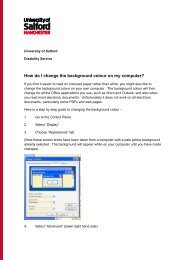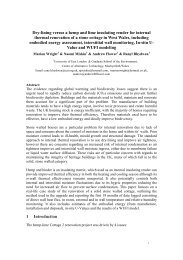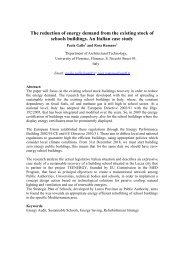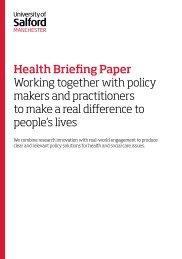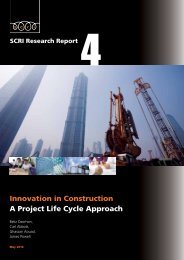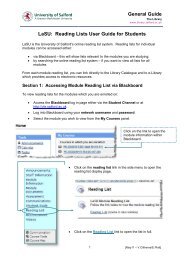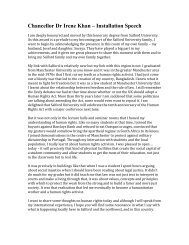FINAL REPORT - University of Salford
FINAL REPORT - University of Salford
FINAL REPORT - University of Salford
You also want an ePaper? Increase the reach of your titles
YUMPU automatically turns print PDFs into web optimized ePapers that Google loves.
Evaluation <strong>of</strong><br />
Bolton Multi-<br />
Agency Referral<br />
Panels (MARPS)<br />
<strong>FINAL</strong> <strong>REPORT</strong><br />
Michael Murphy<br />
Marian Foley<br />
Tony Long<br />
School <strong>of</strong> Nursing,<br />
Midwifery & Social Work<br />
CYP@<strong>Salford</strong>.ac.uk<br />
February 2011<br />
<strong>FINAL</strong> <strong>REPORT</strong>
2<br />
Contents<br />
3 The project team<br />
4 Section 1 – CONTEXT OF THE EVALUATION<br />
4 The national context<br />
4 The local context<br />
5 Focus <strong>of</strong> the evaluation<br />
6 Section 2 – METHOD<br />
6 Data collection<br />
6 Sample<br />
6 Ethical considerations<br />
7 Section 3 – FINDINGS<br />
7 Clarity <strong>of</strong> process<br />
7 Benefits <strong>of</strong> the MARP system for children and families<br />
7 Speed <strong>of</strong> response and appropriateness <strong>of</strong> service<br />
8 Early preventative intervention<br />
8 Better involvement <strong>of</strong> families<br />
8 Increased interagency communication & effectiveness<br />
10 Paperwork<br />
10 Suggestions for improvement and further development<br />
11 Better integration between health and social care<br />
12 Who is not at the table?<br />
12 Resource pressures<br />
13 Section 4 – Conclusion<br />
13 Overall achievement<br />
13 Remaining issues <strong>of</strong> dissatisfaction<br />
13 Joining <strong>of</strong> health and social care systems<br />
13 Coverage <strong>of</strong> the whole town<br />
13 Options for the future<br />
15 REFERENCES<br />
16 Appendix A: Questionnaire for MARP members<br />
18 Appendix B: Questionnaire for referring practitioners
3<br />
The Project Team<br />
The project was undertaken by a team with wide expertise and experience <strong>of</strong> both<br />
practice and research in health and social care with children, young people and families.<br />
All members <strong>of</strong> the research team had current CRB clearance.<br />
Michael Murphy is Senior Lecturer in Social Work.<br />
A qualified social worker and counsellor, he has wide<br />
experience in dealing with substance misuse, looked<br />
after children, chaotic families, and safeguarding<br />
children, and has published widely in these areas.<br />
He acts as a training consultant to several training<br />
organisations, is Chair <strong>of</strong> Bolton Substance Misuse<br />
Research Group, and was an executive member <strong>of</strong> PIAT.<br />
Dr Tony Long is Pr<strong>of</strong>essor <strong>of</strong> Child and Family Health.<br />
A Registered Child Health Nurse, his personal research<br />
programmes are in evaluation <strong>of</strong> early intervention in<br />
health and social care services for children and families,<br />
parental coping, and clinical research on quality <strong>of</strong> life<br />
outcomes for children and families after treatment for<br />
cancer.<br />
Marian Foley has twelve years experience <strong>of</strong> working<br />
in statutory children’s services as a practitioner,<br />
manager and practice educator. She is a Lecturer<br />
in Social Work and teaches on the BA Social Work<br />
programme.<br />
Research With Children and Families.<br />
CYP@<strong>Salford</strong><br />
This research group includes child health nurses, social workers, learning disability specialists, midwives, mental<br />
health nurses, doctors, and others who focus on children, young people & families.<br />
www.nursing.salford.ac.uk/research/n&m-research/childrenandyoungpeople/index.php
4<br />
Section 1 - Context <strong>of</strong> the Evaluation<br />
CYP@<strong>Salford</strong> - the children and families research team at the <strong>University</strong> <strong>of</strong> <strong>Salford</strong> was<br />
contracted in 2009 to undertake an evaluation <strong>of</strong> the functioning and effectiveness <strong>of</strong><br />
Bolton’s Multi-Agency Referral Panels (MARPs) processes.<br />
Notation throughout this report:<br />
SM = Senior Manager<br />
PM = Panel Member<br />
RP = Referring Practitioner<br />
The National Context<br />
For the past decade a key aim <strong>of</strong> central government<br />
in England has been to reduce the social exclusion<br />
<strong>of</strong> children and their families by early, interagency,<br />
intensive involvement as soon as a child’s extra needs<br />
become apparent. This aim is best expressed in<br />
Every Child Matters (Department for Education and<br />
Skills (DfES) 2003) and Reaching out: think family<br />
(Social Exclusion Taskforce (SET) 2007). These policy<br />
documents expressed a determination to address the<br />
child’s extra needs directly, but also to address the<br />
extra needs <strong>of</strong> the parent that may lead to the social<br />
exclusion <strong>of</strong> the child. A recent research overview<br />
from The Centre for Excellence and Outcomes in<br />
Children and Young People’s Services (C4EO 2010)<br />
has demonstrated the efficacy <strong>of</strong> early, preventative<br />
approaches in assisting better development in children<br />
and a better sense <strong>of</strong> wellbeing in family life.<br />
The Local Context<br />
Bolton’s Early Years Service is still intent on the<br />
provision <strong>of</strong> a quality universal service to all children in<br />
Bolton. However, the borough’s 15 children’s centres<br />
are moving away from universal entitlement for all to<br />
an early screening service for children with additional<br />
needs. As part <strong>of</strong> Bolton’s universal contact schedule<br />
(15 contacts between the age <strong>of</strong> 0-5 yrs with all<br />
services) the borough is attempting to set up an early<br />
(pre-Common Assessment Framework) screening<br />
service that will ensure that children’s additional needs<br />
are identified and addressed as early as possible. The<br />
MARP provides the vehicle for the partnership element<br />
<strong>of</strong> this work.<br />
In this way, in terms <strong>of</strong> Horwath and Morrison’s<br />
(2007) classification <strong>of</strong> collaboration (communication,<br />
cooperation, coordination, coalition and integration),<br />
the aim was to move from the relatively ad-hoc stage<br />
<strong>of</strong> communication, where practitioners would talk<br />
together in an unstructured way to coordination - a<br />
more formalized pattern <strong>of</strong> joint working. The process<br />
in Bolton <strong>of</strong> children moving between the thresholds <strong>of</strong><br />
responses is outlined in Figure 1.<br />
For nearly four decades the safeguarding system<br />
in Britain has provided the vehicle for interagency<br />
collaboration at threshold four and above, and most<br />
authorities have also developed child in need systems<br />
at threshold three (Jones and O’Loughlin 2003).<br />
Systems for collaboration around the needs <strong>of</strong> disabled<br />
children are <strong>of</strong>ten also well-developed. However,<br />
the challenge <strong>of</strong> coordinating the early response to<br />
children for whom universal services (threshold one)<br />
are not sufficient remains significant (McInnes 2007,<br />
Frost 2005). Often the vehicle for this work is underdeveloped<br />
or does not exist, and the gap between<br />
thresholds one and three can be substantial. In some<br />
ways, the concentration <strong>of</strong> interagency resources on<br />
threshold three and above has left children and families<br />
at lower threshold levels with services that are relatively<br />
less coordinated and integrated.
5<br />
FAMILIES BETTER<br />
WORKING ACROSS BOUNDARIES TO SUPPORT<br />
Child Protection Processes<br />
LEVEL FOUR<br />
Specialist Services<br />
LEVEL THREE<br />
Targeted Services<br />
LEVEL TWO<br />
Children’s Centre Resources Management Panel<br />
LEVEL ONE/TWO<br />
Early Intervention/Preventative Services<br />
LEVEL ONE<br />
UNIVERSAL CONTACT SCHEDULE<br />
No <strong>of</strong> contacts<br />
EVERY CHILD<br />
OPEN ACCESS SESSIONS<br />
Figure 1: Movement between thresholds in<br />
Bolton<br />
This report does not address the extra challenges<br />
<strong>of</strong> significant constraints in resources that recent<br />
reductions in Bolton’s child care budget have brought<br />
about, but these severe reductions in resources<br />
must, to some degree, shape the direction <strong>of</strong> future<br />
preventative services in the borough.<br />
As part <strong>of</strong> this process, Multi-Agency Referral Panels<br />
(MARPs) were set up with representatives from<br />
midwifery, health visiting, Early Start, Homestart, family<br />
support and social care. These panels, that began in the<br />
Tong area in April 2009 then spread to the Great Lever<br />
and Horwich areas, invite referrals from concerned<br />
practitioners and attempt to identify vulnerable children<br />
and their families for whom universal provision is<br />
not sufficient, so that appropriate resources may be<br />
directed to them in as effective a manner as possible.<br />
Although the panels all undertake the same type <strong>of</strong><br />
work, they have inevitably developed slightly different<br />
cultures and ways <strong>of</strong> operating. Because <strong>of</strong> the earlier<br />
start in Tong, several respondents thought that this<br />
panel had managed to iron out some <strong>of</strong> the early<br />
difficulties and reached a more advanced stage <strong>of</strong><br />
development.<br />
(SM) We probably need to say that Tong MARP was<br />
more developed.<br />
Some respondents believed that the setting up <strong>of</strong><br />
the MARPs was a logical response to an interagency<br />
problem that was in keeping with the tradition <strong>of</strong><br />
flexible, cooperative, interagency collaboration that<br />
had been evident in this local authority for some<br />
time (Murphy 1996, Jones and O’Loughlin 2003).<br />
Throughout the research there was a strong sense <strong>of</strong><br />
a system, created by key managers and practitioners,<br />
designed to improve the early threshold child care<br />
service.<br />
(SM) This is what we have always done in Bolton.<br />
Bringing staff together at an earlier stage to try to<br />
develop the service we <strong>of</strong>fer. We aim to have real<br />
togetherness and early intervention to all mothers<br />
from the midwifery service onwards. Let us be a bit<br />
more flexible at an earlier stage – let us be more in<br />
tune with what clients need. Let us try to fit them<br />
rather than they trying to fit into our system. We<br />
needed to properly share information and to avoid<br />
gaps and duplication.<br />
(SM) Before the MARPS there was nothing at this<br />
level.<br />
Focus <strong>of</strong> the Evaluation<br />
Primarily, the evaluation concerned the effectiveness<br />
<strong>of</strong> the panel in making a positive early difference<br />
to the lives <strong>of</strong> the targeted vulnerable children. The<br />
evaluation examined the effectiveness <strong>of</strong> three MARPs<br />
in concentrating and shaping the interagency response<br />
to the children and families that were referred.
6<br />
Section 2 - Method<br />
Data Collection<br />
The evaluation elicited views and experiences from<br />
practitioners who had referred children and families<br />
into the MARP process, from the practitioners and<br />
managers who made up the three panels, and<br />
from the senior managers who had an overview <strong>of</strong><br />
the whole process. All participants were asked how<br />
effective the MARPs had been in addressing the<br />
needs <strong>of</strong> referred children and families. For ethical<br />
and practical reasons, individual children and<br />
families were not followed through the process,<br />
rather those involved in the process as referrers,<br />
members and managers were asked about their<br />
experiences.<br />
The three MARPs’ immediate consumers are the<br />
practitioners who refer families to the panel.<br />
Normally these are practitioners and managers<br />
from the statutory, voluntary, independent and<br />
private sectors who are concerned about a<br />
particular child and their family, referring them<br />
to the panel for assistance in galvanising an early<br />
interagency response. The experiences <strong>of</strong> these<br />
staff were elicited through an online or hard-copy<br />
questionnaire or structured telephone interview.<br />
Within a six months period from October 2009 to<br />
March 2010 the research team invited responses<br />
from all members <strong>of</strong> each panel and at least one<br />
practitioner or manager from each referring agency<br />
to each panel. At a later date senior managers<br />
were interviewed to elicit their views on how the<br />
panels were working.<br />
Sample<br />
Responses were obtained from 14 MARP members<br />
(6 North, 2 South, and 8 West). Most <strong>of</strong> these panel<br />
members were from health visiting, Early Start and<br />
children’s centres. The majority <strong>of</strong> the panel members<br />
had served on the panel since it was set up in their<br />
area. Six senior managers were also interviewed.<br />
Responses were received from eight referring<br />
practitioners, though only five completed the<br />
questionnaire. Four were health visitors and the fifth<br />
was a Community Worker Team Leader. All had been<br />
qualified and been in post for more than three years.<br />
The latter had not referred to the panel. Referrals were<br />
all to the North or West panel.<br />
Ethical Issues<br />
Formal approval was secured from the <strong>University</strong> <strong>of</strong><br />
<strong>Salford</strong> Research Ethics Panel. All participants were<br />
informed <strong>of</strong> the study and their potential role in it.<br />
Identifying details were not required other than to<br />
invite potential participants. Data was stored securely<br />
with password protected access restricted to the<br />
immediate research team.<br />
The questionnaires and interviews focused on<br />
achievements, impact, and ideas for improvement.<br />
A draft questionnaire was amended through<br />
discussion with a panel <strong>of</strong> stakeholders and was<br />
piloted before use.
7<br />
Section 3 - Findings<br />
Clarity <strong>of</strong> Process<br />
We asked respondents if they believed that the<br />
MARP process was clear. From the panels, only one<br />
respondent thought that it was unclear while the<br />
rest believed that it was clear. Of the four relevant<br />
referring practitioners, three reported that the<br />
process was clear, while the fourth thought that<br />
it was unclear. This distinction was not based on<br />
difference in target panel.<br />
The benefits <strong>of</strong> the MARP system for<br />
children and families<br />
As far as the benefits to children and families were<br />
concerned, the respondents from panels and the<br />
senior managers stated that the speed <strong>of</strong> response,<br />
the early involvement <strong>of</strong> families and early<br />
identification <strong>of</strong> need were the distinct advantages<br />
<strong>of</strong> the process. In most responses the advantages<br />
<strong>of</strong> the MARP way <strong>of</strong> doing things was favourable<br />
compared to previous processes (or in some<br />
cases the lack <strong>of</strong> a process). In the same way the<br />
members <strong>of</strong> the panels believed that the process<br />
was reasonably fast and practitioner friendly.<br />
There was dissent from this view by some referring<br />
practitioners. Benefits were identified, the view<br />
<strong>of</strong> outcomes varied, and there was considerable<br />
concern about some aspects.<br />
Speed <strong>of</strong> response and<br />
appropriateness <strong>of</strong> service<br />
The speed <strong>of</strong> response and appropriateness<br />
<strong>of</strong> service <strong>of</strong>fered were both thought by panel<br />
members to bring a real advantage to families.<br />
There was a real sense that the MARP process<br />
brought an end to the delays <strong>of</strong> multiple referral<br />
systems and systemic delays.<br />
(PM) The family receives an intervention fairly<br />
quickly by an appropriate person<br />
(PM) Generally it is a quick turn around<br />
(PM) Swift and easy referral for families who are<br />
experiencing difficulties<br />
(PM) Quick access to additional service<br />
(PM) Families are usually allocated a worker within a<br />
week<br />
(PM) Quick and easy referral for support<br />
(PM) Swifter response<br />
(PM) A relevant pr<strong>of</strong>essional is assigned to the family<br />
(PM) Appropriate additional support is provided by<br />
pr<strong>of</strong>essionals at source<br />
Responses from referring practitioners were split,<br />
with three reporting that it was relatively quick and<br />
one reporting that it was relatively slow. The latter<br />
was linked to what was seen to be cumbersome<br />
bureaucracy, particularly due to the reliance on<br />
paperwork. Although reporting that the process was<br />
relatively quick, one practitioner recommended further<br />
expediting <strong>of</strong> cases.<br />
(RP) Telephone referral to a clerical person would<br />
help to speed up the process further and minimise<br />
paperwork.<br />
Referring practitioners sought appropriate support for<br />
families; parenting support and advice; introduction to<br />
support services and groups in the area; [the service to]<br />
address the needs identified on the referral (eg: sleep<br />
management, behaviour support, parenting issues); and<br />
a generally high standard <strong>of</strong> service.<br />
On the whole this was what they experienced, with<br />
appropriate practitioners taking the cases on, though<br />
there was disagreement about the degree to which this<br />
impacted positively on families.<br />
(RP) The staff delivering the care and very good and<br />
reliable. Work is completed to a high standard.<br />
(RP) In most cases the work was completed. We did<br />
have some referrals refused due to work loads.<br />
(RP) Staff take on the referral and complete it to a<br />
high standard.<br />
(RP) [The outcome for the family was that the case<br />
was] allocated to the relevant worker.<br />
(RP) Not much improvement in the family situation.<br />
(RP) Short form, allocated to a local worker, multiagency<br />
panel means the referral is looked at and the<br />
best person for the job picks it up.
8<br />
Early preventative Intervention<br />
Although response guidelines have been routinised<br />
in safeguarding (DCSF 2010) and assessment work<br />
(DH 2000) for some time, the response that families<br />
receive at lower thresholds can involve significant<br />
delay. What the MARP has attempted to do is to<br />
shorten the normal ‘drift’ that occurs when a family<br />
is referred between several agencies. One advantage<br />
<strong>of</strong> a speedy response is that it is hoped that early<br />
intervention will prevent some families from reaching<br />
the Safeguarding threshold.<br />
(PM) The MARP also identifies the low-level at-risk<br />
families early. This enables effective preventative<br />
work.<br />
(PM) Early intervention to alleviate any issues before<br />
they reach crisis point.<br />
(PM) Dysfunctional families/children are identified<br />
early and interventions put in place before further<br />
escalation.<br />
(PM) Quick access to services.<br />
(SM) Early involvement around preventative work. If<br />
we get the average young mum breast feeding then<br />
she is <strong>of</strong>f to a flying start.<br />
(SM) It is an opportunity for pr<strong>of</strong>essionals to get<br />
together round a table, in a safe arena, to talk<br />
about families they wouldn’t normally have the<br />
opportunity to talk about. The right pr<strong>of</strong>essionals<br />
are there at the meeting and can decide things<br />
swiftly.<br />
(SM) This can mean that the support is put in to the<br />
family before things begin to deteriorate.<br />
Once again, the cumbersome nature <strong>of</strong> the referral<br />
process as seen by referring practitioners reduced the<br />
impact <strong>of</strong> the intended early intervention in their view.<br />
One practitioner reported that the issues <strong>of</strong> delay<br />
caused by multi-agency involvement were still present<br />
after referral.<br />
(RP) The families end up with different agencies<br />
working with them who do not communicate<br />
well. Information is kept in separate records. This is<br />
against the recommendations <strong>of</strong> Lord Laming.<br />
Better involvement <strong>of</strong> family<br />
Another significant challenge to all preventative<br />
interventions is how well and at what stage the family<br />
are fully included in the helping process. The response<br />
from the panel members indicates that the MARP<br />
process was successful in better including families in<br />
the helping process.<br />
(PM) Parents are more involved in the process.<br />
(PM) As the relationship [with the family] develops<br />
other issues may be disclosed and, again, appropriate<br />
action can be <strong>of</strong>fered.<br />
(PM) The process provides a forum for the family to<br />
discuss problems and issues.<br />
Increased interagency communication and<br />
effectiveness<br />
The difficulties <strong>of</strong> interagency communication,<br />
information sharing and coordination between<br />
agencies in the safeguarding system have been well<br />
rehearsed over the last thirty eight years (DHSS 1974,<br />
Joint Inspectors Report 2002, Laming 2003, Murphy<br />
2004, Brandon et al 2009). Less well-rehearsed have<br />
been the difficulties <strong>of</strong> collaboration at earlier threshold<br />
stages. The Common Assessment Framework (CAF)<br />
was introduced in 2005 to help with early threshold<br />
collaboration, but difficulties in collaboration persist.<br />
The MARPs were originally intended to smooth out<br />
some <strong>of</strong> the difficulties in interagency collaboration at<br />
the threshold stages between one, two and three.<br />
Increased interagency communication, response and<br />
effectiveness were seen by panel members and senior<br />
managers to be driven by the MARP process and were<br />
held to be helpful to children, parents and practitioners<br />
alike.<br />
(PM) It <strong>of</strong>fers a swift referral system which avoids<br />
duplication <strong>of</strong> work.<br />
(PM) More effective communication.<br />
(PM) The MARP encourages interagency working to<br />
provide holistic, life-changing care to families.<br />
(PM) Effective multi-agency working, improved<br />
relationships, greater understanding <strong>of</strong> other services,<br />
improved communication.<br />
(PM) It is multi-agency so that there are a variety <strong>of</strong><br />
resources to access.<br />
(PM) Multiagency approach to information sharing<br />
about families with additional needs.<br />
(SM) It is an agreed way <strong>of</strong> sharing information. It<br />
helps practitioners unpack their assessments.
9<br />
(SM) Sharing knowledge about the family (some<br />
difficulties at first with sharing info but this seems to<br />
have been sorted out in Tong).<br />
(PM) Multi-agency working which improves<br />
communication.<br />
(PM) More effective communication.<br />
(PM) Information is shared in a relevant and timely<br />
manner.<br />
(RP) Opportunity to share information [is an<br />
advantage <strong>of</strong> the MARP process].<br />
Naturally, interagency communication may also assist<br />
in single-agency working.<br />
(RP) [One advantage is] a more formal approach<br />
to single agency working. Improved sharing <strong>of</strong><br />
information, quicker follow-up, and more specific<br />
work/actions completed with the family lead to<br />
improved outcomes for the family.<br />
Some difficulties remained.<br />
(RP) We are having some difficulties with<br />
information-sharing and are currently looking to<br />
clarify the parameters. In most cases the issue is<br />
dealt with.<br />
It also became clear from the responses <strong>of</strong> participants<br />
that there were distinct advantages for agencies in<br />
the earlier easing <strong>of</strong> interagency collaboration. This<br />
included simply bringing agencies and pr<strong>of</strong>essionals<br />
together.<br />
(SM) We have had the staff learning about each<br />
other and forming better working relationships.<br />
(SM) They are multi-disciplinary which gets you <strong>of</strong>f<br />
to a good start. They <strong>of</strong>fer a holistic look at families<br />
needs from them.<br />
(SM) Health is very central and is well linked in to<br />
the whole process.<br />
(PM) Decisions are made and discussed as a panel.<br />
All agencies are able to comment and express<br />
opinions, ideas and suggestions.<br />
(PM) A single meeting point has helped in fostering<br />
interagency relationships.<br />
(PM) Provides an appropriate forum to discuss<br />
interventions and progress.<br />
(PM) Cohesion in working together.<br />
(PM) Building and developing better relationships<br />
between partners and agencies.<br />
(PM) Appropriately trained personnel delivering<br />
services to families in line with identified need.<br />
(SM) It is also a way <strong>of</strong> bringing an integrated teams<br />
together.<br />
(PM) Enables individual agencies to liaise with other<br />
pr<strong>of</strong>essionals to <strong>of</strong>fer appropriate solutions.<br />
(PM) Teams working more closely together.<br />
It also impacted on more timely delivery <strong>of</strong> services.<br />
(PM) Swift and easy referral for agencies with<br />
concerns about a family.<br />
(PM) Dysfunctional families/children are identified<br />
early and interventions put in place before further<br />
escalation.<br />
The inclusion <strong>of</strong> feedback, review, and remedial action<br />
were held to be important aspects, too.<br />
(PM) Feedback.<br />
(PM) Less duplication <strong>of</strong> work.<br />
(PM) The situation is monitored on a regular basis.<br />
(SM) It helps manage the anxiety <strong>of</strong> early thresholds<br />
work.<br />
(SM) It also helps practitioners with their anxiety<br />
about thresholds.<br />
(SM) Built in is a shared evaluation/review process.<br />
(SM) They are tracking families process through the<br />
MARP – this has got to be an advantage.<br />
(SM) The MARPS have been streamlining the<br />
preventative response <strong>of</strong> the range <strong>of</strong> services that<br />
are available. This is the need and the intervention.<br />
When will we review? When will we know if the<br />
intervention has been successful?<br />
It also became clear that there were advantages in<br />
developing early knowledge about families.<br />
(SM) When you have health and staying safe social<br />
care teams come together it has got to be good<br />
news – they just complement each other. The early<br />
lining-up <strong>of</strong> midwife, HV and Children’s Centres led<br />
to much better demonstrable positive effect (even<br />
though afterwards children might go up threshold –<br />
we knew that they needed to be there).
10<br />
(SM) Clear early way <strong>of</strong> process.<br />
There was also a distinct advantage in the perceived<br />
localness <strong>of</strong> the service, both in terms <strong>of</strong> awareness<br />
<strong>of</strong> local need and knowledge about possible<br />
responses to that need. Referring practitioners sought<br />
introduction to support services and groups in the<br />
local area.<br />
(SM) The MARPS see local need and deprivation.<br />
There are less gaps now.<br />
(SM) We did have an option <strong>of</strong> having senior<br />
managers meeting (like in Warrington) – but<br />
we thought that MARPS needed to be staff at a<br />
practice level in each locality.<br />
The early organisers <strong>of</strong> the MARPs avoided a system<br />
that would have seen senior managers representing<br />
their agencies on the panels. This option could have<br />
removed the decision-making process away from local<br />
staff, potentially limiting their effectiveness (Glisson<br />
& Hemmelgarn 1998). Preserving this ‘localness’ is<br />
discussed further below.<br />
Paperwork<br />
At higher threshold levels, the systems that were<br />
designed to help with the interagency process (the<br />
Assessment Framework, the CAF, the Integrated<br />
Children’s System) have in fact added a huge burden<br />
<strong>of</strong> paperwork to practitioners in the system (Munro<br />
2010). We asked the panel members if the MARP<br />
process involved a reasonable amount <strong>of</strong> paperwork.<br />
All respondents agreed with this statement. Several<br />
noted the real advantage that the MARP forms had<br />
over the CAF process.<br />
(PM) The simpler referral form to fill in as opposed<br />
to the CAF - a quicker referral pathway - the input<br />
into families is much quicker.<br />
(PM) It is a focussed, clear process. The paperwork is<br />
easier to fill in and understand.<br />
(PM) An effective paper trail for monitoring<br />
purposes.<br />
(PM) Feedback for records with regular updates.<br />
This advantage <strong>of</strong> an early ‘tracking’ system for<br />
families about whom there are concerns was also<br />
mentioned by senior managers.<br />
Suggestions for improvement/Further<br />
Development<br />
The response from both the users <strong>of</strong> MARPs and<br />
the panel members was overwhelmingly favourable,<br />
but some dissatisfaction was voiced by referring<br />
practitioners. It is frequently the case that more can<br />
learned from areas <strong>of</strong> dissatisfaction or suggested<br />
improvement. In this study there were several<br />
suggestions to make the system work even better.<br />
One issue concerned the streamlining <strong>of</strong> the current<br />
process or the combining <strong>of</strong> the MARP processes with<br />
other processes to make it more efficient:-<br />
(PM) The MARP should be used as a means to<br />
deliver the Healthy Child Programme (which includes<br />
progressive universalism). That way the function<br />
<strong>of</strong> the MARP would be very clear with one line <strong>of</strong><br />
authority and responsibility. There is not a clear<br />
structure for responsibility and authority as each<br />
organisation has own protocols and responsibilities<br />
(PM) Presently there are 2 pathways for referrals<br />
which are not always clear.<br />
(RP) I have concerns regarding the cost implications<br />
<strong>of</strong> the MARP meetings. Prior to MARP I would refer<br />
a family to our team nursery nurse. This process<br />
required no paper work, no meeting, no joint visits.<br />
Liaison was direct within the team.. It did not require<br />
a meeting with several pr<strong>of</strong>essional all on good<br />
salaries sat round for an hour to hand over one<br />
referral. I find this process very costly as we also need<br />
to include the travelling expenses for the pr<strong>of</strong>essional<br />
who attend the meeting. A typical cost for one<br />
meeting is £100 which would pay for 10hrs nursery<br />
nurse provision. The need to do a joint visit at the<br />
beginning and the end <strong>of</strong> the piece <strong>of</strong> work takes 3<br />
members <strong>of</strong> staff. This again cost £80 for both visits.<br />
It seems a very expensive way to deliver a package <strong>of</strong><br />
care. The quality <strong>of</strong> the work delivered is excellent.<br />
The staff within the team are very approachable.<br />
My concerns are the systems in place and the cost<br />
implications.<br />
There was also widespread discussion about the<br />
threshold level that was appropriate for MARPS, and to<br />
what extent the MARP process should include the CAF<br />
process. However, one senior manager commented that<br />
“The threshold issue is a normal one that is going to<br />
get discussed around every service/new development.”
11<br />
For some respondents it would be important to keep<br />
the MARP at a pre-CAF level.<br />
(PM) The MARP was initially for low level<br />
interventions. This has grown to include referrals<br />
from social care (via phone calls or initial<br />
assessments). A clear, rigorous pathway needs to be<br />
developed so that the MARP functions as one team<br />
rather than separate agencies using it as a workallocation<br />
meeting.<br />
(PM) The MARP works because it is a low level<br />
service (pre CAF). For it to be effective it needs to<br />
stay this way. More agencies attending. Outcomes<br />
for families need to be decided at the meeting<br />
rather than on the referral form.<br />
is not always “SMART”.<br />
(SM) Some pr<strong>of</strong>essionals are reluctant to share and<br />
they need to be confident that they are sharing the<br />
right information to the right people.<br />
(RP) I find the MARP meetings can end up with the<br />
wrong information being shared. I feel that children’s<br />
centre staff do not have a full appreciation <strong>of</strong> health<br />
visiting roles and confidentiality regarding medical<br />
health information, and at times they are receiving<br />
information and reports from health pr<strong>of</strong>essionals<br />
that are inappropriate.<br />
Most respondents thought that these issues had been<br />
largely worked out, but concerns persisted among<br />
others.<br />
One senior manager wanted the CAF to become<br />
central to the MARP process.<br />
(SM) Better use <strong>of</strong> the CAF process. Consider whole<br />
family rather than just child (not sure how they<br />
engage the family around the CAF. It’s a referral<br />
document).<br />
Another was sure that the MARP process would have<br />
to move up thresholds in response to the resource<br />
crisis affecting the child care service in Bolton<br />
and there was practical dissention from referring<br />
practitioners.<br />
(SM) There will be a move up the framework to a<br />
slightly more targeted threshold – we cannot afford<br />
to <strong>of</strong>fer this at a universal threshold. The MARPs will<br />
be the mechanism for this. They will be extended<br />
to higher levels <strong>of</strong> family support. We need to link<br />
processes in at all thresholds <strong>of</strong> vulnerability.<br />
(RP) I would prefer the work was handed to<br />
members <strong>of</strong> the skill mix team within the health<br />
visitor service. Once the families are at a higher level<br />
in the framework for action, and become within the<br />
remit <strong>of</strong> social services it is then appropriate for a<br />
family worker to become involved.<br />
There were also some issues to be resolved regarding<br />
the proper sharing <strong>of</strong> information.<br />
(PM) Too many separate child records. Laming<br />
recommended one set. This would be safer and<br />
easier if integration was complete and health visitors<br />
took the lead.<br />
(PM) Issues remain with informed consent and the<br />
sharing <strong>of</strong> information. Local authority staff are not<br />
aware <strong>of</strong> Caldicott requirements. Information shared<br />
Better integration between health and<br />
social care services<br />
There was also some concern that although the MARP<br />
process had brought better collaboration, there was still<br />
a gap between the processes <strong>of</strong> health and social care.<br />
(SM) We don’t have targeted social care allocations<br />
– this doesn’t fit with the MARP process. The social<br />
care manager is there but allocation is separate. (In<br />
terms <strong>of</strong> the threshold discussions this is not helpful).<br />
(SM) From a social care perspective, we need to link<br />
in better to see if they have already gone through the<br />
MARP process.<br />
(RP) It is difficult to know the strengths <strong>of</strong> staff who<br />
you do not work with regularly. Often members<br />
<strong>of</strong> the health visitor team are best placed to work<br />
with the family initially. If a lengthy piece <strong>of</strong> work or<br />
support is needed then it could be referred to MARP.<br />
However regular written reports need to be given to<br />
the health visitor involved with the family to be put in<br />
the records. Often support workers stop the support<br />
without consulting the health visitor, on the say so <strong>of</strong><br />
their manager. I really dislike the system. There is a lot<br />
<strong>of</strong> room for improvement.<br />
It would seem advisable that these two processes<br />
were brought together under the wider MARP banner,<br />
though this might need to be after the current social<br />
care restructuring is completed.<br />
(SM) Children’s centres, staying safe family support<br />
and contact centres will eventually be amalgamated<br />
into one preventative service.
12<br />
Who is not at the table?<br />
In any interagency process, who to include and<br />
who to leave out are always difficult judgements to<br />
make. Because <strong>of</strong> the way the MARPs were set up,<br />
several agencies were not involved in the process and<br />
these absences might be problematic in the future<br />
development <strong>of</strong> the MARPs, particularly if it is to be<br />
developed beyond the early years age group. The<br />
most obvious absentee is education.<br />
(SM) Get education in there – they are not<br />
represented at the moment.<br />
(SM) Education is not at the table – that needs to be<br />
sorted out.<br />
In terms <strong>of</strong> the needs <strong>of</strong> families with children <strong>of</strong><br />
three and above, and in terms <strong>of</strong> local knowledge <strong>of</strong><br />
need and deprivation, schools in particular need to be<br />
represented.<br />
A challenge to the further development <strong>of</strong> the MARPs<br />
is the future inclusion <strong>of</strong> adult-oriented services<br />
(particularly mental health, substance and learning<br />
disability services). This bringing together <strong>of</strong> child and<br />
adult-oriented systems is both essential and difficult<br />
(Murphy and Oulds 2000, Ravey et al 2008).<br />
get other people in at an early stage it can take the<br />
burden <strong>of</strong>f the midwife.<br />
(SM) How many MARP panels do we need? One for<br />
each geographically defined area? It is not as easy for<br />
midwives – but we could have a named midwife for<br />
each area. (There are huge changes in the pipeline<br />
for midwifery).<br />
Senior managers were also particularly concerned<br />
about the impact <strong>of</strong> the current financial crisis.<br />
(SM) The ring fence has been taken <strong>of</strong>f children’s<br />
centres so they have become vulnerable to reorganisation<br />
and redundancy. It becomes difficult to<br />
afford with the financial crisis for social care. Whilst<br />
the MARPs are doing quite well in terms <strong>of</strong> sharing<br />
information and care, there are some threats to their<br />
future development. At the moment social care is in<br />
such a resource crisis, further moves to co-location<br />
have stalled.<br />
(SM) We don’t have panels in every district – this was<br />
planned but is in limbo at the moment. We have five<br />
now. The plan is for six to cover the whole borough.<br />
(SM) Link with adult services. Substance, mental<br />
health and housing. They are not represented now.<br />
I’m not sure that they even know what the MARP is<br />
about. At lower thresholds they are not well linked<br />
into family centres etc so can’t be included in the<br />
service. We are working with the child’s presenting<br />
problem rather than getting to what is causing it.<br />
Resource Pressures<br />
One <strong>of</strong> the pressures from a senior manager level was<br />
the resource demand <strong>of</strong> staffing the MARPs. Although<br />
in the end it is hoped the MARPs will cut down<br />
agency workload, in the meantime agencies have to<br />
staff the panels with representatives.<br />
(SM) One concern I do have is how numerous are<br />
they going to get? If I am to send a midwife to<br />
every one, how much work will that be? At one<br />
time we thought every family centre was going to<br />
have one. We are generally there for the whole<br />
meeting – so some <strong>of</strong> the discussions are about<br />
older children in families that we do not have a role<br />
in. But as far as the staffing is concerned, if we can
13<br />
Section 4 - Conclusion<br />
This study has revealed that the MARP process<br />
has brought considerable improvement to the<br />
early preventative stages <strong>of</strong> child care services in<br />
Bolton. Both from the perspective <strong>of</strong> the deliverers<br />
<strong>of</strong> the service (practitioners and managers) and<br />
the receivers <strong>of</strong> the service (children and parents),<br />
the MARPS have brought significant positive<br />
change. One good example <strong>of</strong> this is the speed <strong>of</strong><br />
response. It is known that parents <strong>of</strong>ten feel that<br />
they have been struggling with family problems for<br />
a significant period <strong>of</strong> time before help is <strong>of</strong>fered<br />
(Murphy et al 2008), and, although practitioners<br />
understand delays within their own agency, they<br />
frequently find other agency delays more difficult<br />
to understand (Murphy 2004). Increasing the<br />
speed <strong>of</strong> response helps both parent and system.<br />
If there is agreement that the MARP works on<br />
the whole (with some remaining anomalies), then<br />
how it should develop in the future is a key issue.<br />
Would it be possible or desirable to return to the<br />
pre-MARP system? To do this would automatically<br />
return early threshold, preventative child care work<br />
back to an non-integrated, non-collaborative stage<br />
<strong>of</strong> development, with the traditionally haphazard<br />
allocation <strong>of</strong> resources and significant delay. If<br />
returning to the old system is not advisable, how<br />
can the MARP process develop and respond to the<br />
new challenges <strong>of</strong> child care in Bolton in 2011?<br />
Remaining issues <strong>of</strong> dissatisfaction<br />
Reponses from referring practitioners were<br />
relatively few, but within these concerns were<br />
raised about the ease <strong>of</strong> working with the system<br />
from their perspective, and the consistency <strong>of</strong><br />
positive outcome for families. It would seem that<br />
additional work is needed to harmonise the views<br />
and needs <strong>of</strong> referring practitioners and those <strong>of</strong><br />
panel members and senior managers.<br />
the research, the significant national and local<br />
reorganisations may challenge the feasibility <strong>of</strong> this<br />
integration. Moreover, remaining uncertainty at the<br />
referral level <strong>of</strong> the cost-effectiveness <strong>of</strong> the MARP<br />
approach requires attention.<br />
Coverage <strong>of</strong> all the town<br />
It seems logical to expand the coverage <strong>of</strong> the MARPs<br />
to the rest <strong>of</strong> the borough, and the options for how<br />
this could be achieved are discussed below.<br />
Options for the future<br />
Clearly, whatever decisions are made about the future<br />
<strong>of</strong> the MARPs, this must necessarily involve some<br />
compromise between an ideal or best possible system<br />
and the real constraints <strong>of</strong> the current financial crisis<br />
(Figure 2).<br />
Local need with many MARPS vs fewer<br />
MARPS which are easier to staff<br />
This is the crucial dilemma for the future <strong>of</strong> the MARP.<br />
There seems to be a tension MARPs and on the other<br />
hand a strategy focused on higher threshold, more<br />
centralised, fewer MARPs, which would be less costly<br />
in terms <strong>of</strong> staffing.<br />
Before CAF or inclusive <strong>of</strong> CAF<br />
At what threshold level the MARP should be located<br />
is equally arguable. Although there are tangible<br />
advantages to keeping the MARP in a pre-CAF stage,<br />
it is not clear if this remains an affordable option.<br />
Joining <strong>of</strong> health and social care<br />
systems<br />
The MARP process seems to have suggested the<br />
need to further integrate the preventative systems<br />
<strong>of</strong> health and social care. Although the need<br />
for this integration was apparent throughout
14<br />
Figure 2: Tensions between alternative strategies for the future <strong>of</strong> MARPs
15<br />
Section 4 - References<br />
Brandon M, Belderson P, Warren C, Howe D,<br />
Gardner R, Dodsworth J, Black J (2008) Analysing<br />
child deaths and serious injury through abuse and<br />
neglect: what can we learn? London: DCSF.<br />
Centre for Excellence and Outcomes in Children<br />
and Young People’s Services (2010) Grasping the<br />
nettle: early intervention for children, families and<br />
communities London: C4EO.<br />
Department <strong>of</strong> Health and Social Security (1974)<br />
Report <strong>of</strong> the committee <strong>of</strong> inquiry into the care and<br />
supervision provided in relation to Maria Colwell.<br />
London: HMSO.<br />
Department <strong>of</strong> Health (2000) The framework for<br />
assessment <strong>of</strong> children in need and their families.<br />
London: HMSO.<br />
Department for Education and Skills (2003) Every<br />
child matters London: HMSO.<br />
Department for Children Schools and Families<br />
(2010) Working together to safeguard children.<br />
London: TSO.<br />
Frost N (2005) Pr<strong>of</strong>essionalism, partnership and<br />
joined up thinking. A research review <strong>of</strong> front-line<br />
working with children and families. www.rip.org.uk.<br />
McInnes K (2007) A practitioner’s guide to<br />
interagency working in children’s centres: a review <strong>of</strong><br />
the literature. London: Barnardos.<br />
Munro E (2010) The Munro review <strong>of</strong> child protection:<br />
part 1 a systems analysis London: DfE.<br />
Murphy M (1995) The child protection unit. Aldershot:<br />
Avebury.<br />
Murphy M, Oulds G (2000) Establishing and<br />
developing cooperative links between substance<br />
misuse and child protection systems. In Harbin F,<br />
Murphy M (Eds) Substance misuse and child care.<br />
Lyme Regis: RHP.<br />
Murphy M (2004) Developing collaborative<br />
relationships in interagency child protection work.<br />
Lyme Regis: RHP.<br />
Ravey M, Murphy M, Long T, Fallon D (2008)<br />
Evaluation <strong>of</strong> the Blackpool Council Springboard<br />
Project. <strong>University</strong> <strong>of</strong> <strong>Salford</strong>.<br />
Social Exclusion Task Force (2007) Reach out - think<br />
family. London: Cabinet Office.<br />
Glisson C, Hemmelgarn A (1998) The effects <strong>of</strong><br />
organizational climate and interorganizational<br />
coordination on the quality and outcomes <strong>of</strong><br />
children’s service systems. Child Abuse and Neglect<br />
22(5) 401-421.<br />
Horwath J, Morrison T (2007) Collaboration,<br />
integration and change in children’s services: critical<br />
issues and key ingredients. Child Abuse and Neglect<br />
31:55-69.<br />
Joint Chief Inspectors Report (2002) Safeguarding<br />
children: a Joint Chief Inspectors report on<br />
arrangements to safeguard children. London: DH.<br />
Jones L, O’Loughlin T (2003) A child concern model<br />
to embrace the framework. In Calder M, Hackett S<br />
(Eds) Assessment in child care. Lyme Regis: RHP.<br />
Laming H (2003) The inquiry into the death <strong>of</strong><br />
Victoria Climbie. London: HMSO.
16<br />
Appendix 1 - Referring Practitioner Questionnaire<br />
Bolton MARP Referring Practitioner<br />
2. About you<br />
We would like to ensure that we have gained responses from the breadth <strong>of</strong> practitioners who refer into the MARP.<br />
We don’t need to know any personal details, but it would be helpful if you would provide the information asked for<br />
below.<br />
1. To which practice group do you belong?<br />
2. How long have you been qualified?<br />
Less than 1 year<br />
At least 1 year but less than 3 years<br />
3 years or more<br />
3. How long have you been in post?<br />
Less than 1 year<br />
At least 1 year but less than 3 years<br />
3 years or more<br />
3. Experience <strong>of</strong> referring to the MARP - your referral<br />
This short section is about your referral<br />
4. Have you ever referred to the MARP?<br />
Yes<br />
No<br />
5. To which MARP have you referred?<br />
North South West<br />
6. How many families have you referred?<br />
1 2 3 4 5 More than 5<br />
7. What did you hope to gain from the referral?
17<br />
4. Experience <strong>of</strong> referring to the MARP - Outcomes<br />
This section is about the outcome <strong>of</strong> your referral<br />
8. Was the MARP process clear?<br />
Yes<br />
No<br />
9. Did the MARP process involve only a reasonable amount <strong>of</strong> paperwork?<br />
Yes<br />
No<br />
10. Was the MARP process fast enough?<br />
Relatively quick<br />
Relatively slow<br />
11. What was the outcome <strong>of</strong> your MARP referral for the child/family<br />
5. Last Page!<br />
Finally, please give us your opinion on these issues<br />
12. What would you say are the advantages <strong>of</strong> the MARP process?<br />
13. How could the service be improved?<br />
14. Do you have any comments on issues that we haven’t asked about?
18<br />
Appendix 2 - Panel Member Questionnaire<br />
Copy <strong>of</strong> Bolton MARP - Panel Member<br />
1. What this research evaluation is about<br />
The evaluation team is tasked with 2 main jobs.<br />
1) Pr<strong>of</strong>iling families that have been referred to a MAR panel.<br />
2) Evaluating the impact <strong>of</strong> a MARP referral on the interagency response to those families. (This is the biggest task<br />
and the greatest challenge.)<br />
3) Disseminating the results widely within Bolton and beyond.<br />
We ask you as a MARP member for you views to add to the information from referring practitioners so that we have<br />
a rounded view <strong>of</strong> the strengths and remaining challenges presented by this initiative.<br />
2. About you<br />
We would like to ensure that we have gained responses from a representative selection <strong>of</strong> MARP members. We<br />
don’t need to know any personal details, but it would be helpful if you would provide the information we asked for<br />
below.<br />
1. On which MARP do you serve?<br />
North<br />
South<br />
West<br />
2. Which agency do you represent on the MARP?<br />
3. How long have you served on the MARP?
19<br />
3. The MARP process and outcomes<br />
This section is about the process and outcome <strong>of</strong> the MARP initiative.<br />
4. Is the MARP process clear?<br />
Yes<br />
No<br />
5. Does the MARP process involve only a reasonable amount <strong>of</strong> paperwork?<br />
Yes<br />
No<br />
6. Is the MARP process fast enough?<br />
Relatively quick<br />
Relatively slow<br />
7. Is the MARP process practitioner-friendly?<br />
Yes<br />
No<br />
8. What would you say are the advantages <strong>of</strong> the MARP process for CHILDREN AND FAMILIES?<br />
9. What would you say are the advantages <strong>of</strong> the MARP process for AGENCIES?<br />
10. How could the MARP process be improved?<br />
11. Do you have any comments on issues that we haven’t asked about?
Contact the Centre for Nursing & Midwifery Research:<br />
CYP@<strong>Salford</strong>.ac.uk<br />
This report can be referenced as<br />
Murphy M, Foley M, Long T (2011) Evaluation <strong>of</strong> Bolton Multi-Agency Referral Panels (MARPS).<br />
<strong>University</strong> <strong>of</strong> <strong>Salford</strong>.<br />
ISBN: 978-1-907842-22-1<br />
© <strong>University</strong> <strong>of</strong> <strong>Salford</strong> 2011


